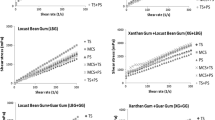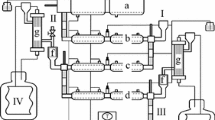Abstract
The purpose of this paper is to present a methodology for characterizing the rheological properties of heterogeneous gastric contents, for the first time, to our knowledge. Pigs were used as a model because their gastric system is similar to that of humans. Bread was chosen as a high-calorific, solid test meal. The bread was made with flours offering a wide range of amylose/amylopectin ratios. A specific method of extraction and measurement was developed. For the study, the vane test technique was chosen in order to take into account the heterogeneity and short lifetime of the boluses. The variation in viscosity values for each gastric system was compared with their moisture contents, different residence times in the stomach, and various amylose/amylopectin ratios. The viscosities decrease significantly as the residence time increases. Furthermore, we suggest that the amylose/amylopectin ratio (Am/Ap) determines the moisture content, which then provides the viscosity level, since the gastric contents behave as a concentrated suspension. Pigs add variability to the results because the structure of the bolus depends on mastication.






Similar content being viewed by others
References
Björck I, Granfeldt Y, Liljeberg H, Tovar J, Asp NG (1994) Food properties affecting the digestion and absorption of carbohydrates. Am J Clin Nutr 59:699S–705S
Edelbroek M, Edelbroek M, Wishart J, Akkermans L (1993) Effects of erythromycin on gastric emptying, alcohol absorption and small intestinal transit in normal subjects. J Nucl Med: Off Publ, Soc Nucl Med 34:582–588
Horowitz M, Edelbroek MAL, Wishart JM, Straathof JW (1993) Relationship between oral glucose tolerance and gastric emptying in normal healthy subjects. Diabetologia 36:857–862
Jebb SA (2007) Dietary strategies for the prevention of obesity. Proc Nutr Soc 64:217–227
Johansen HN, Knudsen KB, Sandstrom B, Skjoth F (1996) Effects of varying content of soluble dietary fibre from wheat flour and oat milling fractions on gastric emptying in pigs. Br J Nutr 75:339–352
Kong F, Singh RP (2008) Disintegration of solid foods in human stomach. J Food Sci 73:R67–R80
Lindberg JE, Arvidsson A, Wang J (2003) Influence of naked barley cultivar with normal, amylose-rich or amylopectin-rich starch and enzyme supplementation on digestibility and piglet performance. Anim Feed Sci Technol 104:121–131
Cherbut C, Albina E, Champ M, Doublier JL, Lecannu G (1990) Action of guar gums on the viscosity of digestive contents and on the gastrointestinal motor function in pigs. Digestion 46:205–213
Deshpande SS, Cheryan M (1984) Effects of phytic acid, divalent cations, and their interactions on α-amylase activity. J Food Sci 49:516–519
Brown NJ, Worlding J, Rumsey RDE, Read NW (1988) The effect of guar gum on the distribution of a radiolabelled meal in the gastrointestinal tract of the rat. Br J Nutr 59:223–231
Potkins ZV, Lawrence TLJ, Thomlinson JR (1991) Effects of structural and non-structural polysaccharides in the diet of the growing pig on gastric emptying rate and rate of passage of digesta to the terminal ileum and through the total gastrointestinal tract. Br J Nutr 65:391–413
Guerin S, Ramonet Y, LeCloarec J, Meunier-Salaün MC, Bourguet P, Malbert CH (2001) Changes in intragastric meal distribution are better predictors of gastric emptying rate in conscious pigs than are meal viscosity or dietary fibre concentration. Br J Nutr 85:343–350
Granfeldt Y, Liljeberg H, Drews A, Newman R, Björck I (1994) Glucose and insulin responses to barley products: influence of food structure and amylose-amylopectin ratio. Am J Clin Nutr 59:1075–1082
Akerberg Å, Liljeberg H, Björck I (1998) Effects of amylose/amylopectin ratio and baking conditions on resistant starch formation and glycaemic indices. J Cereal Sci 28:71–80
Marciani L, Gowland PA, Spiller RC, Manoj P, Moore RJ, Young P, Al-Sahab S, Bush D, Wright J, Fillery-Travis AJ (2000) Gastric response to increased meal viscosity assessed by echo-planar magnetic resonance imaging in humans. J Nutr 130:122–127
Morita N, Maeda T, Miyazaki M, Yamamori M, Miura H, Ohtsuka I (2002) Effect of substitution of waxy-wheat flour for common flour on dough and baking properties. Food Sci Technol Res 8:119–124
Dikeman CL, Murphy MR, Fahey GC (2006) Dietary fibers affect viscosity of solutions and simulated human gastric and small intestinal digesta. J Nutr 136:913–919
Van Hung P, Maeda T, Morita N (2006) Waxy and high-amylose wheat starches and flours—characteristics, functionality and application. Trends Food Sci Technol 17:448–456
Sandhu KS, Singh N (2007) Some properties of corn starches II: physicochemical, gelatinization, retrogradation, pasting and gel textural properties. Food Chem 101:1499–1507
Juhász R, Salgó A (2008) Pasting behavior of amylose, amylopectin and their mixtures as determined by RVA curves and first derivatives. Starch - Stärke 60:70–78
Xie F, Yu L, Su B, Liu P, Wang J, Liu H, Chen L (2009) Rheological properties of starches with different amylose/amylopectin ratios. J Cereal Sci 49:371–377
Sulaiman R, Dolan KD (2013) Effect of amylose content on estimated kinetic parameters for a starch viscosity model. J Food Eng 114:75–82
Macosko CW (1994) Rheology: principles, measurements, and applications. Wiley, New York
Yoshimura AS, Prud’homme RK, Princen HM, Kiss AD (1987) A comparison of techniques for measuring yield stresses. J Rheol 31:699–710
Schipper RG, Silletti E, Vingerhoeds MH (2007) Saliva as research material: biochemical, physicochemical and practical aspects. Arch Oral Biol 52:1114–1135
Tester RF, Morrison WR (1990) Swelling and gelatinization of cereal starches. I. Effects of amylopectin, amylose, and lipids. Cereal Chem 67:551–557
Eastwood MA, Morris ER (1992) Physical properties of dietary fiber that influence physiological function: a model for polymers along the gastrointestinal tract. Am J Clin Nutr 55:436–442
Singh J, Dartois A, Kaur L (2010) Starch digestibility in food matrix: a review. Trends Food Sci Technol 21:168–180
French D (1984) Organization of starch granules. Starch: Chem Technol 2:183–247
Black JL (2001) Variation in nutritional value of cereal grains across livestock species. Proceedings of the Australian Poultry Science Symposium 13, 22–29
Kim JC, Mullan BP, Pluske JR (2005) A comparison of waxy versus non-waxy wheats in diets for weaner pigs: effects of particle size, enzyme supplementation, and collection day on total tract apparent digestibility and pig performance. Anim Feed Sci Technol 120:51–65
Acknowledgments
This work was made possible through the financial support of the French National Research Agency (ANR), within the framework of the Nomac project. We wish to thank all of the partners involved in this project. We wish to extend our grateful thanks to the technical staff of the Laboratoire Rhéologie et Procédés. The Laboratoire Rhéologie et Procédés is part of the LabEx Tec 21.
Conflicts of Interest
The authors have nothing to disclose.
Author information
Authors and Affiliations
Corresponding author
Rights and permissions
About this article
Cite this article
Patarin, J., Blésès, D., Magnin, A. et al. Rheological Characterization of Gastric Juices from Bread with Different Amylose/Amylopectin Ratios. Food Dig. Res Curr Opin 6, 2–9 (2015). https://doi.org/10.1007/s13228-014-0037-9
Received:
Accepted:
Published:
Issue Date:
DOI: https://doi.org/10.1007/s13228-014-0037-9




